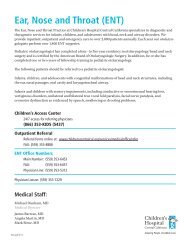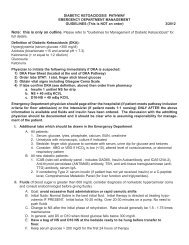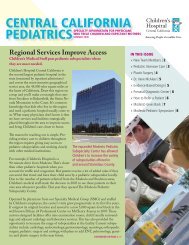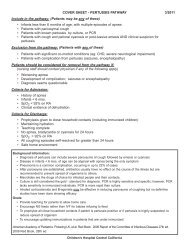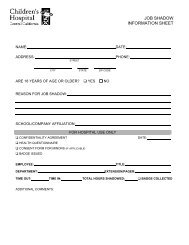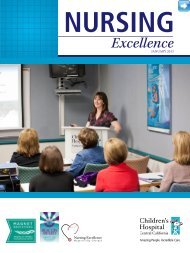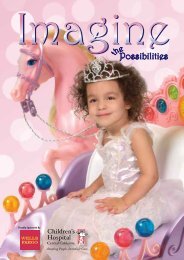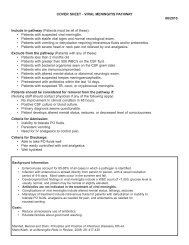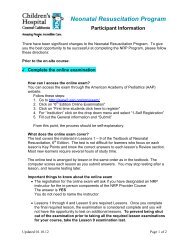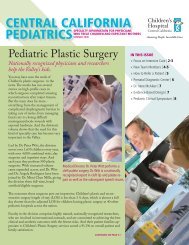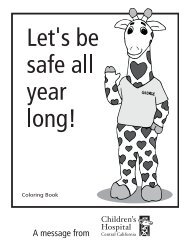Gastroenteritis Pathway - Children's Hospital Central California
Gastroenteritis Pathway - Children's Hospital Central California
Gastroenteritis Pathway - Children's Hospital Central California
Create successful ePaper yourself
Turn your PDF publications into a flip-book with our unique Google optimized e-Paper software.
COVER SHEET GASTROENTERITIS PATHWAY 6/2012<br />
Include in pathway (Patients must be all of these):<br />
• Patients with simple gastroenteritis<br />
• Patients with stable vital signs<br />
• Patients with clinical evidence of dehydration<br />
• Patients with no indication of surgical abdomen<br />
• Inadequate oral intake<br />
Exclude from the pathway (Patients with any of these):<br />
• Patients less than 1 month old<br />
• Patients who are hemodynamically unstable<br />
• Patients with significant chronic comorbid condition (significant neurologic impairment, congenital heart disease,<br />
inflammatory bowel disease, etc.)<br />
• Patients who are immunocompromised<br />
• Patients with vomiting and significant abdominal pain without diarrhea<br />
• Patients with diarrhea of greater than 5 days duration on admission<br />
Patients should be considered for removal from the pathway if:<br />
(Nursing staff should contact physician if any of the following apply)<br />
• No improvement in clinical condition in 48 hours<br />
• Persistent bilious vomiting with abdominal pain<br />
• Primary diagnosis seems questionable<br />
• Stools become grossly bloody<br />
Criteria for Admission:<br />
• Inability to tolerate PO fluids<br />
• Persistent lethargy<br />
• Dehydration with large volume of ongoing diarrhea<br />
• Abnormal respirations<br />
Criteria for Discharge:<br />
• Able to take PO fluids well<br />
• Able to maintain intake equal to output<br />
• Well hydrated<br />
• Safe and stable home environment<br />
Background Information:<br />
• Mild to moderate dehydration (under 10%) is best treated with oral rehydration solutions (Rehydralyte,<br />
Pedialyte). This is often best done as an outpatient.<br />
• Even with vomiting, oral rehydration is safe and effective. Parents should be instructed to give small<br />
amounts (10-30ml at a time) frequently, with time between to allow absorption and gastric emptying.<br />
• In simple gastroenteritis, maintaining oral intake low in fat, high in complex carbohydrates and proteins,<br />
and limiting simple sugars results in more rapid resolution of diarrhea. “Bowel rest” has been shown to<br />
be ineffective and often counterproductive. The “BRAT” diet is also not optimal, as it is very low in protein.<br />
• Acquired lactose intolerance is an unusual complication of gastroenteritis. Breastmilk, lowfat milk or<br />
formula are a recommended part of the diet during gastroenteritis and should not routinely be withheld.<br />
In those few patients who do have ongoing intolerance of milk, soy milk/soy formula provides a simple<br />
alternative.<br />
• Most bacterial causes of gastroenteritis do not need antibiotic treatment. Additionally, treatment of E.<br />
Coli 0157 may increase the risk of H.U.S., and treatment of salmonella increases the risk of chronic<br />
carrier state. Thus, empiric treatment of gastroenteritis with antibiotics should generally be avoided,<br />
even when bacterial causes are suspected.<br />
• Lactobacillus and Acidophilus-containing products (active culture yogurt, acidophilus milk, or lactobacillus<br />
capsules) seem to promote more rapid resolution of symptoms and reduce the risk of C. difficile colitis.<br />
• Antimotility agents such as Diphenoxlylate (Lomotil) or Loperamide (Imodium) are potentially harmful and<br />
should be avoided.<br />
Goals:<br />
• Reduce unnecessary use of antibiotics.<br />
• Promote prompt reintroduction of a regular diet.<br />
• Educate families about good handwashing, oral hydration, and appropriate diet.<br />
• Reduce reliance on IV fluids after the acute phase of gastroenteritis.<br />
Risk of Hemolytic uremic syndrome after antibiotic treatment of Escherichia coli 0157:H7 enteritis: A meta-analysis. 2003. Journal of<br />
Pediatrics 142(3); 349<br />
Amieva, Manuel R. 2005. “Important Bacterial Gastrointestinal Pathogens in Children: A Pathogenesis Perspective” Pediatric Clinics of<br />
North America 52(3): 749-77, vi<br />
Kligler B, Hanaway P, Cohrssen A 2007. “Probiotics in Children” Pediatric Clinics of North America 54(6): 949-67; xi<br />
Children’s <strong>Hospital</strong> <strong>Central</strong> <strong>California</strong>
1.0 .1 cc U IU µg MS TIW QD QID QOD MSO 4 MGSO 4<br />
DRUG SENSITIVITY: WT: kg<br />
ORDERS: GENERIC EQUIVELANT WILL BE DISPENSED UNLESS ORDER SPECIFIES “DO NOT SUBSTITUTE”<br />
General<br />
Admitting physician: ___________________________<br />
Attending physician: ___________________________<br />
Primary service: ¨ <strong>Hospital</strong>ist ¨ Team A ¨ Team B ¨ __________<br />
Patient Status:<br />
Admission Diagnosis:<br />
Condition:<br />
Code status:<br />
Isolation:<br />
x Admit<br />
x Stable<br />
<strong>Gastroenteritis</strong><br />
¨ Full Code or ¨ __________________________<br />
x Contact Precautions<br />
Dietary<br />
Use “Gastro Diet” instructions.<br />
If then, vomiting: If vomiting, attempt small volumes of Pedialyte given frequently, and advance as<br />
tolerated. If oral fluids unsuccessful due to vomiting, give normal saline bolus 20 mL/kg IV over 20-30<br />
minutes if no bolus given in ER. If not vomiting, give formula, breast milk, 2% milk, solid foods or<br />
sugar-free drinks instead of Pedialyte even if patient still has diarrhea.<br />
IVF<br />
RN communication, IVF: Provide IV fluids at 1½ times maintenance for 8 hrs and then Saline lock IV.<br />
Maintenance Fluids (PO plus IV) calculated by 4:2:1 method.<br />
Choice of IV fluids:<br />
• for children under 2 months of age, use D5 ¼ NS + 20 mEq KCl/L<br />
• for children over 2 months of age, use D5 ½ NS + 20 mEq KCl/L<br />
• If admission serum bicarbonate (total CO2) 20, resume use of KCl instead of<br />
K-Acetate. (nurse to call pharmacy)<br />
Notify MD if, Stool: If excessive stool output (>20 mL/kg/day) or patient still vomiting, continue IV<br />
fluids at maintenance.<br />
Once saline locked, do not replace IV if it comes out.<br />
If IV placement fails despite 3 attempts, contact physician to consider placing NG tube instead.<br />
NS bolus option: NS bolus 20 ml/kg 0ml IV one time ONE.<br />
COMMENTS: Dose = 20 mL/kg X 1 if oral fluids unsuccessful due to vomiting.<br />
Give over 20 - 30 minutes, if no bolus given in ER<br />
Medications<br />
Acetaminophen 15 mg/kg (max = 650 mg) PO every 4 hrs PRN T > 38.0º C - 38.9º C or mild pain<br />
(max. dose= 75 mg/kg/day or 4000 mg/day, whichever is less). If patient’s temperature remains above<br />
38.0º C one hour after administration, then give Ibuprofen<br />
Acetaminophen 15 mg/kg (max = 650 mg) PR every 4 hrs PRN T > 38.0º C - 38.9º C or mild pain<br />
(max. dose= 75 mg/kg/day or 4000 mg/day, whichever is less). If patient’s temperature remains above<br />
38.0º C one hour after administration, then give Ibuprofen<br />
<strong>Gastroenteritis</strong><br />
0032<br />
*0032*<br />
pathway 6/2012<br />
Physician’s Order Sheet<br />
page 1 of 2<br />
Patient Label
1.0 .1 cc U IU µg MS TIW QD QID QOD MSO 4 MGSO 4<br />
DRUG SENSITIVITY: WT: kg<br />
ORDERS: GENERIC EQUIVELANT WILL BE DISPENSED UNLESS ORDER SPECIFIES “DO NOT SUBSTITUTE”<br />
Ibuprofen 10 mg/kg (max. dose=400 mg) PO every 6 hrs PRN T >38.9º C or moderate pain. If<br />
patient’s temperature remains above 38º C one hour after administration, then give Acetaminophen.<br />
(Nurse to contact physician for unrelieved pain)<br />
Lactobacillus Rhamnosus Capsule (Culturelle) ___ cap (Fill in desired dose) PO BID - may open<br />
capsule and sprinkle over food or formula.<br />
Desitin topically PRN diaper rash<br />
Nursing Care<br />
Give as much as possible of the fluid PO. for patients who are vomiting, instruct a parent or aid to offer<br />
sips of PO fluid every 5-10 minutes. Choose the PO fluids from the gastro diet. Only use IV fluids to<br />
supplement what the patient cannot take PO.<br />
Measure weight daily.<br />
Activity: No restrictions.<br />
Dressings (Wound) care: 3M Cavilon Durable Barrier Cream (for intact skin) or 3M No-Sting Barrier<br />
Film (for excoriated skin) to diaper area PRN for rash.<br />
If then, Result: Order BMP 12 hrs after initial result if initial total CO2
❏ <br />
❏ <br />
❏ <br />
❏ <br />
❏ <br />
❏ <br />
❏ <br />
❏ <br />
❏ ❏ ❏ ❏ <br />
<br />
<br />
❏ <br />
❏ <br />
❏ <br />
❏ <br />
❏ <br />
❏ <br />
❏ <br />
❏ ❏ ❏ ❏ <br />
❏ ❏ <br />
❏ ❏ ❏ ❏ ❏ ❏ <br />
<br />
<br />
<br />
<br />
<br />
<br />
<br />
<br />
<br />
<br />
<br />
<br />
<br />
<br />
<br />
<br />
<br />
<br />
<br />
<br />
<br />
<br />
<br />
<br />
<br />
<br />
<br />
<br />
<br />
<br />
<br />
<br />
<br />
<br />
<br />
<br />
<br />
<br />
<br />
<br />
<br />
<br />
<br />
<br />
<br />
<br />
<br />
<br />
<br />
<br />
<br />
<br />
<br />
<br />
<br />
<br />
<br />
<br />
<br />
<br />
<br />
<br />
<br />
<br />
<br />
<br />
<br />
❏ <br />
❏ <br />
❏ <br />
❏ <br />
❏ <br />
<br />
<br />
<br />
<br />
<br />
<br />
<br />
<br />
<br />
<br />
<br />
<br />
❏ <br />
❏ <br />
❏ <br />
❏ <br />
❏ <br />
<br />
<br />
<br />
<br />
<br />
<br />
<br />
<br />
<br />
<br />
<br />
<br />
❏ <br />
❏ <br />
❏ <br />
❏ <br />
❏ <br />
<br />
<br />
<br />
<br />
<br />
<br />
<br />
<br />
<br />
<br />
<br />
<br />
❏ <br />
❏ <br />
❏ <br />
❏ <br />
❏ <br />
<br />
<br />
<br />
<br />
<br />
*0006*
Ongoing Interdisciplinary Patient/Family Education Documentation Form<br />
Assessment Key ↓<br />
<strong>Gastroenteritis</strong><br />
Knowledge of Plan of Care or Plan of Treatment<br />
1. Comprehensive, 2. Good, 3. Limited, 4. None, 5. 0ther (explain in comments)<br />
Readiness to learn: 1. Asking pertinent questions, 2. Actively listening, 3. Unreceptive, 4. No interest demonstrated, 5. Distracted<br />
Barriers to learning: 1. No barriers, 2. Low literacy or education level present as a barrier, 3. Cultural, 4. Language, 5. Visual,<br />
hearing, speaking, 6. Religious/spiritual, 7. Cognitive, 8. Emotional, 9. Motivation, 10. Pain or fatigue, 11. Other (identify below)<br />
Accommodations for barriers or methods for teaching: 1. No accommodations needed, 2. Interpreter utilized, 3. Audio Visual<br />
Aids used, 4. Handouts in specific language (specify type of handout) 5. Explanation given, 6. Demonstration given, 7. Referred to class<br />
or session, 8. Other<br />
Learning Outcomes: 1. Indicates understanding or performs successfully, 2. Needs reinforcement, 3. Refuses teaching, 4. Unable to<br />
complete teaching (describe in comments), 5. Unable to learn materials/concepts or give return demonstration, 6. No learner available,<br />
7. Not an issue (not applicable)<br />
Remember: An initial<br />
learning assessment<br />
must be completed on<br />
each learner.<br />
Assessed<br />
Learning Needs<br />
Immunizations<br />
Medications<br />
Nutritional Guidance<br />
Anticipatory Guidance<br />
(Growth and Development)<br />
Hygiene<br />
Signs of dehydration<br />
and inadequate PO intake<br />
Who to call for problems<br />
and reasons to see MD<br />
or go to ER<br />
Good handwashing<br />
Appropriate foods and<br />
fluids for gastro<br />
Review gastro handout<br />
Date<br />
Time<br />
Learner<br />
Plan of Care or Tx<br />
Readiness to learn<br />
Barriers<br />
Accommodations<br />
Learning<br />
Outcomes<br />
License<br />
Comments<br />
Initials<br />
Date________ Signature____________________ Initial________<br />
Date________ Signature____________________ Initial________<br />
Date________ Signature____________________ Initial________<br />
Ongoing entries are dated, timed, and initialed for each entry.<br />
Date, sign, and place your initial at the bottom of each page.<br />
Date________ Signature____________________ Initial________<br />
Date________ Signature____________________ Initial________<br />
Date________ Signature____________________ Initial________<br />
<strong>Gastroenteritis</strong><br />
*0006*<br />
pathway 7/2001<br />
Patient/Family Education Documentation Form
<strong>Gastroenteritis</strong><br />
Education Information for Patients and Families<br />
What is gastroenteritis<br />
It is a word used to describe the symptoms from an infection of the bowels (stomach, small and<br />
large intestines). Usually a simple viral infection is the cause. People often call this the stomach<br />
flu. Other types of infections (such as bacteria or parasites) can cause gastroenteritis too. These<br />
are less common. Rotavirus infection is the most common cause of serious diarrhea (watery<br />
stool) in infants and young children.<br />
How did my child get gastroenteritis<br />
It is spread by close contact with the sick person. You may spread it to your child by not washing<br />
your hands after going to the bathroom, touching someone who is sick, diapering, feeding,<br />
burping or before you fix food.<br />
Who gets gastroenteritis<br />
Any person can catch simple gastroenteritis, but the condition can be more serious in young<br />
children.<br />
How will I know if my child has gastroenteritis<br />
Your child may have:<br />
• fever<br />
• nausea (feeling sick to their stomach)<br />
• a stomach ache or be uncomfortable from stomach cramping<br />
• vomiting (throwing up)<br />
• blood in stool<br />
• no appetite (will not eat or drink)<br />
• not as many wet diapers as usual or less urine than usual when they go to the bathroom<br />
• weakness<br />
• headache<br />
• diarrhea (watery stool)<br />
Some gastroenteritis goes away within 24 hours, but some can last as long as 2 to 5 days (adults<br />
longer). If your child has vomiting and diarrhea, dehydration (not enough liquids for your child)<br />
may be a serious result.<br />
How can I prevent the spread of gastroenteritis<br />
• Wash Your Hands frequently through the day.<br />
• Wash Your Hands after every time you go to the bathroom or change a diaper.<br />
• Do not let food come in contact with human or animal waste.<br />
• It is best to keep your child away from others who are sick.<br />
• DO NOT share drinks or food.<br />
• Clean all drinking and eating utensils (forks, spoons, etc.) after use<br />
• Clean surfaces that come into contact with stool, diapers or other materials that have had<br />
stool on them.<br />
Children’s <strong>Hospital</strong> <strong>Central</strong> <strong>California</strong> • 9300 Valley Children’s Place • Madera CA 93636 • (559) 353-3000<br />
Revised: 10/2008 Review by: 06/2011 Page 1 of 3
<strong>Gastroenteritis</strong><br />
Education Information for Patients and Families<br />
What is the treatment What can I do at home<br />
• Antibiotics will not help viral gastroenteritis. Antibiotics may help with some forms of<br />
bacterial gastroenteritis, but these types are much less common.<br />
• Keeping the infant or child from getting dehydrated (not having enough liquids) is the<br />
main goal of home treatment<br />
• Don't make your child take liquids, formula or breast milk too fast if the child is vomiting<br />
every time you give your child food or liquids. Offer small sips about 10 or 15 minutes<br />
after your child last vomited.<br />
• Use Pedialyte until vomiting has stopped. Pedialyte is good because it helps put back the<br />
body's needed nutrients lost from vomiting. Pedialyte can be bought at your local grocery<br />
or drug store.<br />
• You should not offer large amounts of plain water. Water alone does not replace the<br />
necessary nutrients infants and children loose when there is vomiting and diarrhea.<br />
• If your child is no longer vomiting, try feeding your child some of the foods he/she<br />
normally eats. Offer these foods first, if he/she won't eat, give the Pedialyte solution or<br />
other liquids like formula, breast milk, etc. If your child was on milk before then start<br />
them back on milk.<br />
• Do not offer concentrated sweets such as sugar filled sodas, sports drinks, fruit juices, or<br />
Jell-O water with sugar. These can make diarrhea worse.<br />
• Choose sugar free drinks (diet 7 Up or diet Sprite).<br />
• Do not give medicines that slow the diarrhea. The diarrhea will stop when the bowel is<br />
getting better.<br />
• Feed your child foods low in fat and sugars. Fat is hard to digest.<br />
• Children with gastroenteritis can have foods such as rice, wheat, potatoes, breads, cereals,<br />
lean meats and chicken, fruits, and vegetables.<br />
• Lactose free formula (soy) may be needed for diarrhea that lasts longer than three days.<br />
• Infants and children older than 8 months of age who are given servings of low fat, active<br />
culture yogurt (check label on carton) may have fewer days of diarrhea. If your child does<br />
not like yogurt, acidophilus milk may also be helpful.<br />
• If your child has diarrhea, clean the diaper area as soon as your baby wets or stools. Use<br />
mild soap and water, wash from the front to the back. Expose skin over bottom to air<br />
frequently (leave the diaper off). Use A& D ointment or Desitin as needed.<br />
When should I call my doctor<br />
When your child has:<br />
• Dehydration (not taking enough liquids in) Watch for these things:<br />
o Dryness around the mouth<br />
o No tears when crying<br />
o Dry skin<br />
o Not as many wet diapers as usual or less urine than usual when they go to the<br />
bathroom<br />
o Sunken eyes<br />
Children’s <strong>Hospital</strong> <strong>Central</strong> <strong>California</strong> • 9300 Valley Children’s Place • Madera CA 93636 • (559) 353-3000<br />
Revised: 10/2008 Review by: 06/2011 Page 2 of 3
<strong>Gastroenteritis</strong><br />
Education Information for Patients and Families<br />
o A sunken soft spot (in infants) on the top of their head<br />
o Weakness<br />
o Tired<br />
• mucus, pus or blood in the stool<br />
• lots of stomach cramping or pain<br />
• Fever of 100.4 degrees Fahrenheit for children two months of age or younger. Do not<br />
give Acetominophen (Tylenol) or Ibuprofen (Pediaprofen) before calling your doctor.<br />
• Fever you are concerned about<br />
Call 911, if your child is<br />
• very weak<br />
• limp or not moving<br />
• having seizures (shaking, jerking movements of the body)<br />
• not responding<br />
• passes out<br />
• blue or gray in color<br />
• stops breathing<br />
Start CPR if needed<br />
Children’s <strong>Hospital</strong> <strong>Central</strong> <strong>California</strong> • 9300 Valley Children’s Place • Madera CA 93636 • (559) 353-3000<br />
Revised: 10/2008 Review by: 06/2011 Page 3 of 3
Children’s <strong>Hospital</strong> <strong>Central</strong> <strong>California</strong><br />
SUGGESTED FOODS FOR CHILDREN WITH DIARRHEA<br />
BREAD/STARCHES/CEREALS<br />
Rolls, biscuits or bread; tortillas; saltine & graham crackers;<br />
potatoes, rice and noodles with no butter or rich sauces,<br />
cooked and non-sugarcoated cereals<br />
NOT Croissants, donuts, potato & tortilla chips, sugarcoated<br />
and presweetened cereals<br />
MEATS, CHICKEN, FISH/EGGS<br />
DAIRY PRODUCTS<br />
SOUPS<br />
DRINKS<br />
VEGETABLES and FRUITS<br />
All lean meats, skinless chicken and turkey; all fish and<br />
shellfish; eggs. Prepare all meats, fish, and chicken by<br />
baking, broiling or simmering. Tofu, beans, lentils and peas<br />
NOT Hot dogs, bacon, sausage and fatty lunch<br />
meats and any fried meats, chicken, fish or eggs<br />
Encourage low fat and non fat yogurt. (Check label for active<br />
culture yogurt.) Low fat cheeses such as mozzarella and<br />
string cheese; skim, acidophilus, 1% or low-fat milks.<br />
NOT Whole milk and whole milk products such as<br />
American cheese, jack cheese, cheddar cheese and cream<br />
cheese, ice cream and sherbets<br />
Broth, soups with fat removed.<br />
NOT Soups made with cream, whole milk and high fat<br />
cheese<br />
Sugar-free Kool-Aid, sugar-free and caffeine-free<br />
carbonated beverages; Pedialyte<br />
NOT Regular sodas, Kool-Aide and punch, coffee,<br />
caffeine-containing drinks, Gatorade, and all fruit drinks<br />
Fruits and vegetables in small amounts are OK for children<br />
with diarrhea<br />
OTHER<br />
NOT Desserts and sweets such as cookies,<br />
cakes,pies, candy, as well as jelly, honey, syrup and<br />
sugar (can substitute sugar-free gelatin)<br />
NOT Fats and oils<br />
Children’s <strong>Hospital</strong> <strong>Central</strong> <strong>California</strong>
Discharge Sheet<br />
Dictation: 1-800-411-1001 (#963)<br />
D/S Job #: ________<br />
For <strong>Hospital</strong> Use Only<br />
Discharge sheet FAXed to PCP _______________<br />
initial/date<br />
Follow-up appointment SCHEDULED with PCP _______________<br />
initial/date<br />
Patient’s Name______________________________<br />
Discharge Date:___________________<br />
Dx: 1) <strong>Gastroenteritis</strong> 2) Dehydration 3) ___________________________<br />
<strong>Hospital</strong> Course<br />
• Patient admitted for acute onset vomiting and diarrhea; estimated dehydration ___________%<br />
• Treated with IV fluids and oral fluids. Solid foods reintroduced successfully.<br />
Rotazyme neg Wright’s Stain: normal<br />
pos<br />
mod to many polys<br />
not done<br />
pending<br />
Admission<br />
electrolytes<br />
Discharge<br />
electrolytes<br />
Complications during hospitalization: ________________________________________________<br />
___________________________________________________________________________<br />
Discharge Condition: ________________________________<br />
Discharge weight: ___________<br />
Instruction to Patient<br />
Activity: As tolerated<br />
Diet: Provide plenty of liquids. Please refer to “Diet Education Sheet for Patients with <strong>Gastroenteritis</strong>”.<br />
Medications: See Medication Reconciliation Form<br />
Additional instructions: Careful handwashing should be practiced by all household contacts.<br />
Signed: ________________________________ M.D. ____________________________________<br />
Signature of Parent or Guardian<br />
_______________________________________<br />
Attending Physician<br />
_______________________________________<br />
Primary Care Physician<br />
<strong>Gastroenteritis</strong><br />
____________________________________<br />
Attending Resident<br />
____________________________________<br />
City<br />
Patient Label<br />
0083<br />
*0083*<br />
pathway 6/2012<br />
Discharge Instructions



